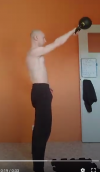Brett Jones
StrongFirst Director of Education
Master Certified Instructor
Elite Certified Instructor
Beast Tamer
I think removing the one-arm swing to see how the shoulder responds is a good strategy.
Let's see what comes about.
Let's see what comes about.

